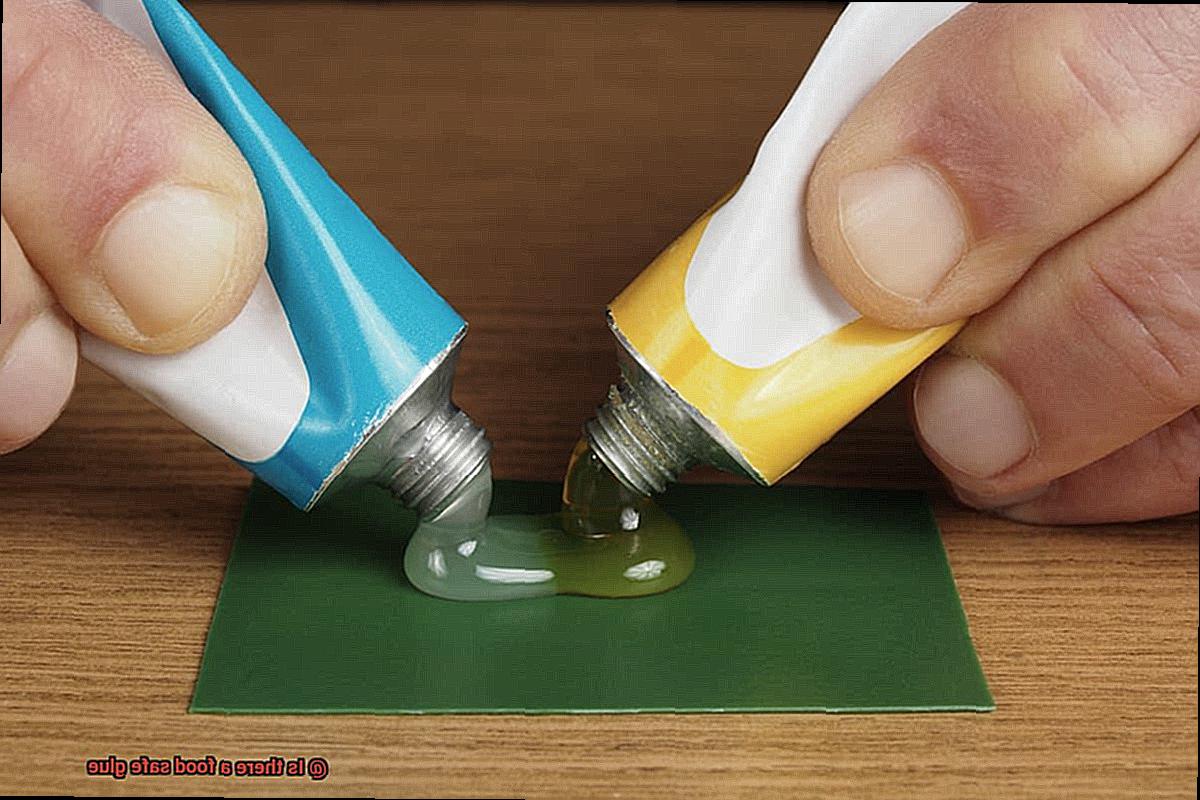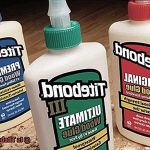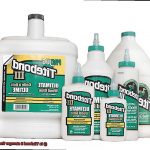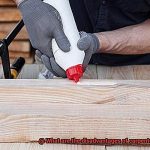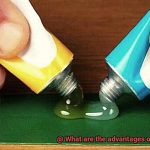Have you ever been in a sticky situation where you needed to fix something in the kitchen or stick something onto a food surface? If so, you might have wondered, “Hey, is there a glue that won’t poison my pasta?”
Well, good news. There are actually glues out there that are safe to use with food.
These special glues have been carefully crafted to meet all the safety regulations and standards, so they won’t release any nasty chemicals or toxins when they come into contact with your precious grub. In this post, we’re going to dive into the world of food-safe glues and explore their different types and uses.
So buckle up and get ready for some adhesive adventures in the kitchen.
The Different Types of Food Safe Glues
Contents
- 1 The Different Types of Food Safe Glues
- 2 Key Considerations When Choosing a Food Safe Glue
- 3 Common Materials Used in Food Safe Glues
- 4 Determining Whether a Glue Is Food Safe
- 5 Advantages of Using Food Safe Glues
- 6 Disadvantages of Using Food Safe Glues
- 7 How to Properly Apply and Cure Food Safe Glues
- 8 Conclusion
These special glues act as superheroes, protecting us from harmful substances that could sneak into our food. So, put on your lab coats and let’s dive into the various types of food-safe glues available on the market.
Epoxy Resin Glue: The Mighty Protector
Imagine a glue that can withstand water, chemicals, and even high temperatures – that’s epoxy resin glue. This superhero adhesive forms an unbreakable bond, making it perfect for kitchen appliances and utensils. From sealing cracks in your favorite mixing bowl to repairing a chipped glass container, epoxy resin glue has got your back.
Epoxy resin glues are commonly used in food-related applications due to their excellent adhesive properties and resistance to water, chemicals, and high temperatures. They are formulated with ingredients that comply with FDA regulations for direct contact with food. These glues are often used for repairing kitchen utensils, sealing joints in cutting boards, or fixing ceramic or glass containers.
Cyanoacrylate Glue: The Speedy Fixer
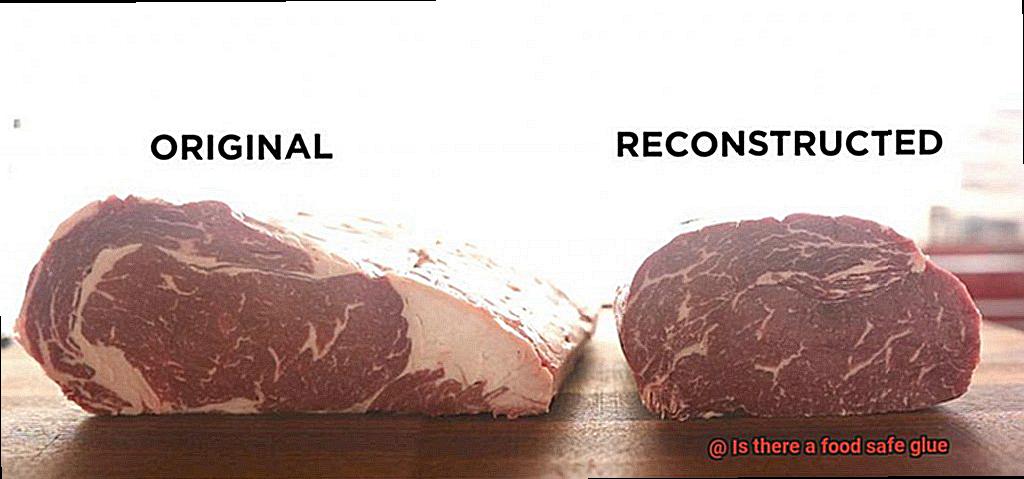
If you’re looking for a quick fix, cyanoacrylate glue, also known as super glue, is the one for you. This fast-drying adhesive sticks to almost anything – plastics, ceramics, metals – you name it. It’s like having a tiny sidekick in your pocket, ready to save the day by fixing your cracked mug or broken plate.
However, not all cyanoacrylate adhesives are safe for use with food. It is crucial to look for cyanoacrylate glues that are explicitly labeled as food safe or have FDA approval. These glues are commonly used for bonding small parts of kitchen equipment or repairing items made of plastic or rubber.
Silicone Adhesive: The Flexible Guardian
Flexible, waterproof, and heat-resistant – silicone adhesive is the ultimate hero for sealing and bonding food containers or appliances that face heat or moisture. Whether you’re sealing the edges of your lunchbox or fixing a leaky blender gasket, this adhesive will keep your food safe from harm.
Silicone adhesives are popular for their flexibility, durability, and resistance to moisture and high temperatures. They are commonly found in food-grade applications such as sealing gaskets or bonding parts of kitchen appliances. Food-safe silicone adhesives should be certified by the FDA and meet specific regulations to ensure they do not release harmful chemicals when in contact with food.
Food Grade Silicone Sealants: The Secret Weapon
Sealing gaps and seams can be a tough task, but fear not. Food-grade silicone sealants are here to save the day. These specialized glues are non-toxic and safe for use in food preparation areas.
Key Considerations When Choosing a Food Safe Glue
When it comes to choosing a food safe glue, there are several key considerations to keep in mind. Whether you are repairing a broken kitchen utensil or creating a DIY project involving food-related items, selecting the right adhesive is crucial for both safety and effectiveness. Here are some factors to consider when choosing a food safe glue:
- Ingredients: Look for glues that are specifically labeled as food safe or FDA approved. These glues are typically made from non-toxic materials that are safe to come into contact with food. Avoid glues that contain harmful substances such as lead or formaldehyde.
- Adhesive Properties: Food safe glues should have strong adhesive properties to ensure a reliable bond. They should be able to bond well with different surfaces such as glass, ceramics, plastic, and metal. Consider the specific needs of your project and choose a glue that can withstand the stress of handling and washing.
- Temperature Resistance: Consider whether the glue can withstand high temperatures without melting or releasing toxic fumes. This is particularly important if the glued item will be used in hot environments or exposed to heat during cooking or baking. Look for glues that have a high temperature resistance and can maintain their bond under extreme heat.
- Drying Time: Some food safe glues may have longer drying times, which can be inconvenient if you need to use the item immediately. Look for glues that dry quickly while still providing a strong and durable bond. However, be cautious of glues that dry too quickly as they may not allow for proper bonding.
- Versatility: Check if the glue can be used on a variety of materials, such as glass, ceramics, plastic, and metal. This versatility allows for more flexibility in its applications. It also saves you from having to purchase multiple types of glues for different materials.
- Specific Requirements or Restrictions: Consider any specific requirements or restrictions you may have. For example, if you are looking for a vegan-friendly option, check if the glue contains any animal-derived ingredients. Similarly, if you have allergies or sensitivities, make sure to read the product labels carefully for any potential allergens.
- Safety Precautions: Follow the safety precautions recommended by the manufacturer. Some food safe glues may require proper ventilation during use or have specific instructions for application and cleanup. It is important to use the glue in a well-ventilated area and avoid direct skin contact or ingestion.
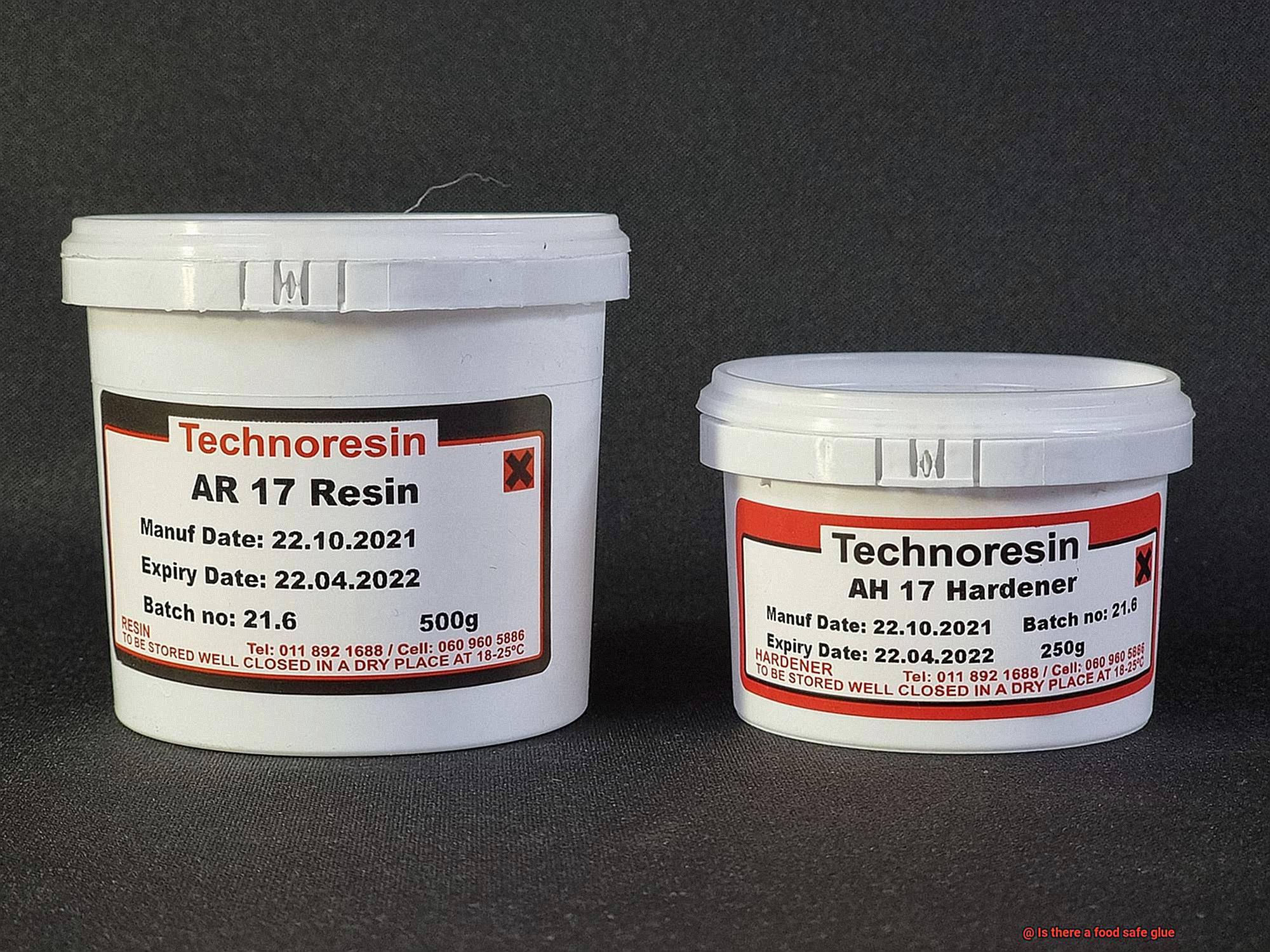
Now let’s take a closer look at some popular types of food safe glues and their pros and cons:
Epoxy Resin Glue:
- Pros: Forms an unbreakable bond, excellent for bonding different materials, resistant to heat and chemicals.
- Cons: Requires mixing two components, longer curing time.
Common Materials Used in Food Safe Glues
When it comes to food safe glues, you want to ensure that not only are they effective at bonding surfaces together, but also safe for human consumption. After all, nobody wants to bite into a sandwich only to find out that the glue used to hold it together is toxic. So, what are the common materials used in food safe glues? Let’s delve into this topic and explore the options.
Polyvinyl acetate (PVA) is one of the most prevalent materials found in food safe glues. This synthetic polymer boasts robust bonding properties and is considered non-toxic. When PVA comes into contact with food, it doesn’t release any harmful chemicals, allowing you to enjoy your meal without any worries.
In addition to PVA, cyanoacrylate is another material frequently used in food safe glues. This fast-setting adhesive forms a strong bond between surfaces and is often employed in food packaging and labeling applications. Its moisture resistance ensures your food stays fresh and secure, preventing any unexpected sandwich mishaps.
Some food safe glues also contain natural ingredients like starch or cellulose. Derived from plants, these materials are safe for consumption and are commonly utilized in applications where accidental ingestion may occur, such as labels or stickers on fruits and vegetables. So, if you accidentally eat a sticker on your apple, rest assured that the glue holding it on won’t harm you.
Silicone-based adhesives are another popular choice for food safe applications. These glues are well-known for their high temperature resistance and flexibility, making them ideal for use in food processing equipment and appliances. Whether it’s a scorching oven or a freezing cold freezer, silicone-based adhesives can withstand it all without compromising safety.
However, it’s crucial to note that not all glues labeled as “food safe” are suitable for all types of food contact. Some may be specially formulated for dry food applications, while others may be suitable for wet or oily foods. Always refer to the specific instructions and recommendations provided by the manufacturer to ensure the glue is appropriate for your intended use.
The manufacturing process of food safe glues also plays a significant role in ensuring their safety. Glues produced in facilities that adhere to strict quality control standards and comply with food safety regulations are more likely to be considered food safe. So, it’s essential to choose glues from reputable manufacturers with a commitment to quality and safety.
When using food safe glues, following proper application instructions and allowing sufficient drying or curing time is crucial. This ensures that the glue forms a strong bond, preventing it from coming off or contaminating the food.
Determining Whether a Glue Is Food Safe
Then, you know the importance of using glue that is safe for food. Whether you’re fixing a broken kitchen utensil or creating stunning food displays, you need to make sure that the glue you’re using won’t pose any health risks. So, how can you determine if a glue is food safe? Let me break it down for you.
First and foremost, look for certifications or approvals from regulatory bodies like the FDA or EFSA. These certifications guarantee that the glue has undergone rigorous testing and meets specific safety standards for use in food-related applications. We all want our sandwiches to be safe, right?
But wait, there’s more. Not all glues are created equal when it comes to food safety. You need to choose glues that are explicitly labeled as “food safe” or “food grade.” These glues are specially formulated to be non-toxic and won’t leach any harmful substances into your food. It’s like having a seal of approval from a renowned chef.
If reading labels isn’t your thing, don’t worry. Another way to determine if a glue is food safe is by examining its ingredients. Watch out for certain chemicals like formaldehyde or volatile organic compounds (VOCs), which can be toxic when ingested. Glue with these harmful substances should be avoided like a burnt toast.
Now, here’s where things get exciting. There are glues available on the market made from natural ingredients or designed specifically for food contact. These glues are typically free from harmful chemicals and are considered safe for use with food. It’s like using farm-fresh ingredients in your recipe – you know exactly what you’re getting.
To make things even easier, take some time to research reputable brands and manufacturers known for producing food-safe glues. This will provide an extra layer of assurance that the glue you’re using is as safe as a well-cooked meal.
Advantages of Using Food Safe Glues
In the food industry, where safety and hygiene are paramount, every component that comes into contact with food must meet rigorous standards. One often overlooked yet essential element is the adhesive used in these applications. Food safe glues offer a multitude of advantages that ensure the integrity and safety of our food products. In this article, we will explore the top benefits of using food safe glues.
Safety First:

Food safe glues are formulated to be non-toxic and free from harmful chemicals, ensuring they do not contaminate food. These glues undergo rigorous testing and adhere to strict regulations, providing consumers with peace of mind that their food is safe for consumption.
Protecting Health:
Regular glues may contain solvents or chemicals that can be hazardous when in contact with food. Food safe glues eliminate these concerns and play a crucial role in maintaining good health standards. By using adhesives that pose no health risks, manufacturers prioritize the well-being of both themselves and their consumers.
Strong Adhesion:
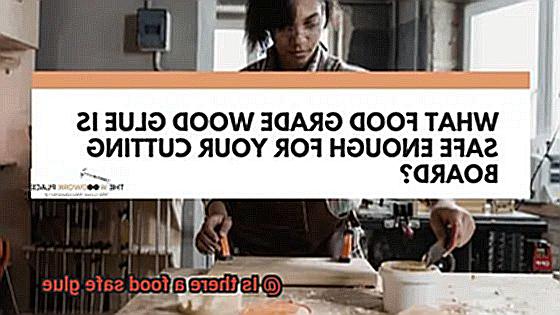
Food safe glues boast excellent adhesion properties, securely bonding different materials used in food-related applications. This ensures that packaging remains intact, preventing contamination or spoilage of the food inside. Whether it’s paper, cardboard, plastic, glass, or metal, these glues provide a reliable bond.
Versatility:
With various formulations available, food safe glues are versatile enough to suit different applications. Manufacturers can use a single adhesive for multiple purposes, reducing inventory costs and simplifying production processes. From labeling to sealing, food safe glues are suitable for a wide range of materials.
Ease of Use:
Food safe glues are designed for user-friendly application methods such as squeeze bottles or brush applicators. This ease of use makes them suitable for both industrial and household applications. By saving time and effort during assembly or packaging, these glues increase overall efficiency.
Compliance with Food Regulations:
Food safe glues are formulated to comply with regulations set by governing bodies such as the FDA or EFSA. They undergo stringent testing to meet required standards for direct and indirect food contact. By using food safe glues, manufacturers ensure compliance, avoiding potential legal issues.
Disadvantages of Using Food Safe Glues
Food safe glues are crucial for ensuring the safety and integrity of our food products. However, it is important to be aware of their drawbacks before fully relying on them for all adhesive needs. This article aims to provide a comprehensive overview of the disadvantages associated with using food safe glues, including compromised adhesive properties, higher cost, limited shelf life, longer drying time, material compatibility constraints, and limited availability.
Compromised Adhesive Properties:
One major drawback of food safe glues is their potential lack of strength and durability compared to regular glues. The incorporation of ingredients to make them food safe can sometimes compromise their adhesive properties. Consequently, they may not be as effective in bonding certain materials together, particularly in high-stress applications.
Higher Cost:
Food safe glues often come with a higher price tag compared to regular glues. The additional steps and precautions taken to ensure their safety for use with food increase production costs. This can make them less accessible and affordable for consumers, especially for larger projects that require a significant amount of glue.
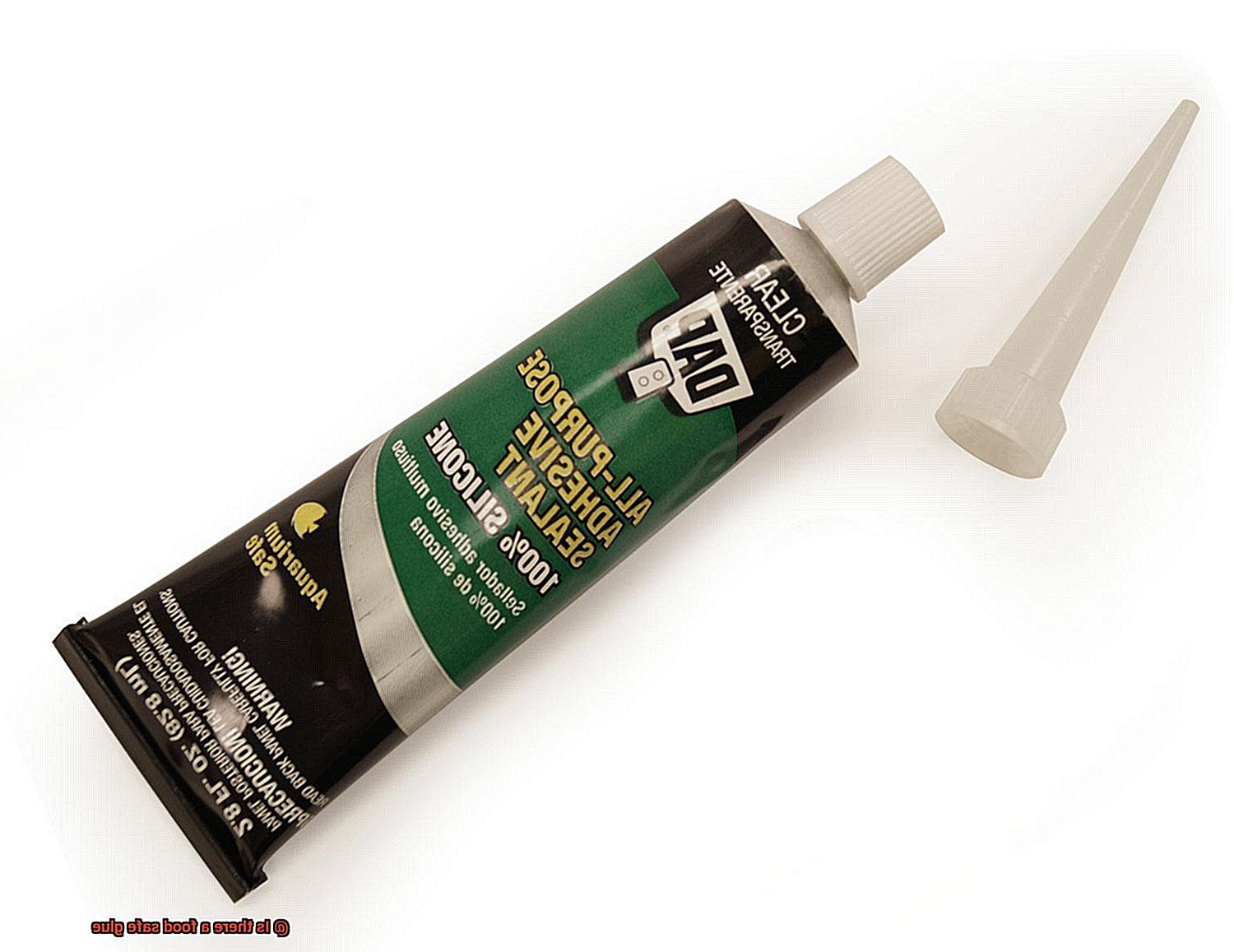
Limited Shelf Life:
Due to the organic or natural ingredients used, food safe glues tend to have a shorter shelf life compared to regular glues. They are more susceptible to spoilage or degradation over time, which reduces their effectiveness as they age. It is crucial to check the expiration date and follow recommended storage instructions to ensure the glue remains safe and usable.
Longer Drying Time:
Certain food safe glues may have a longer drying time compared to regular glues. The specific ingredients used in these glues can affect the curing process, leading to extended drying times and delayed full bonding. This can be inconvenient for time-sensitive projects or when multiple layers of glue need to be applied.
Material Compatibility:
Not all materials are suitable for food safe glues. Some materials, such as plastics or metals, require specific types of adhesives that are not considered food safe. This limitation restricts the versatility of food safe glues and renders them unsuitable for certain applications.
Limited Availability:
Unlike regular glues that are widely available in hardware stores or supermarkets, food safe glues may require specialty stores or online purchases. This limited availability can make it more inconvenient for consumers to find and purchase these glues when needed.
How to Properly Apply and Cure Food Safe Glues
When it comes to repairing or creating food-related items, using food-safe glues is essential. These glues are specifically designed to be safe for use in food preparation and consumption. However, it is important to know how to properly apply and cure them to ensure a strong and safe bond. In this guide, we will walk you through the steps to ensure the effectiveness and safety of your food-safe glue application.
Proper Application: Ensuring a Clean Surface for Bonding
To start, it is crucial to clean and prepare the surfaces that will be bonded. Eliminate any dirt, grease, or debris by using a clean cloth or mild detergent. The manufacturer’s instructions for the specific glue being used should be followed as different glues may have different application methods such as brushing, spraying, or spreading with a spatula. Applying the appropriate amount of glue is essential – not too little, as it may result in a weak bond, and not too much, as excess glue can potentially contaminate the food.
Curing Process: Allowing Sufficient Time for Bond Strength
After applying the glue, it requires time to cure properly. The curing time varies depending on the type of glue and materials being bonded. To achieve optimal results, allow the glue enough time to fully cure before using the bonded item for food preparation. It is recommended to cure glues at room temperature in a well-ventilated area. Avoid exposing the glued item to extreme temperatures or high humidity during the curing process.
Safety Precautions: Protecting Yourself and Others
While applying and curing food-safe glues, take necessary safety precautions. Wearing gloves will protect your hands from direct contact with the glue. Additionally, working in a well-ventilated area prevents inhaling any fumes that may be emitted by the glue. Keep the glue away from children or pets to ensure their safety.
Testing the Bond: Ensuring Strength and Reliability
Once the glue has fully cured, it is essential to test the bond before using the item for food purposes. Apply gentle pressure or pull on the bonded surfaces to check if they hold firmly. Any signs of weakness or detachment should prompt reapplication of the glue and repetition of the curing process.
Cleaning and Maintenance: Hygiene for Continued Use
After bonding with food-safe glue, proper cleaning is necessary to maintain hygiene. Most food-safe glues can be cleaned with warm soapy water. Avoid using harsh chemicals or abrasive cleaners that could damage the bond or contaminate the food. Thoroughly rinse and dry all surfaces before using them for food preparation.
23hOMH8hskk” >
Also Read: Is Glue Edible? – Glue Things
Conclusion
In conclusion, the quest for a food safe glue is not an easy one.
While there are glues on the market that claim to be food safe, it is important to exercise caution and do thorough research before using them. The FDA does not regulate or approve specific glues for direct food contact, so it is crucial to consider the ingredients and potential risks involved.
Additionally, it is advisable to opt for natural alternatives like beeswax or food-grade adhesives when working with items that will come into contact with food.

